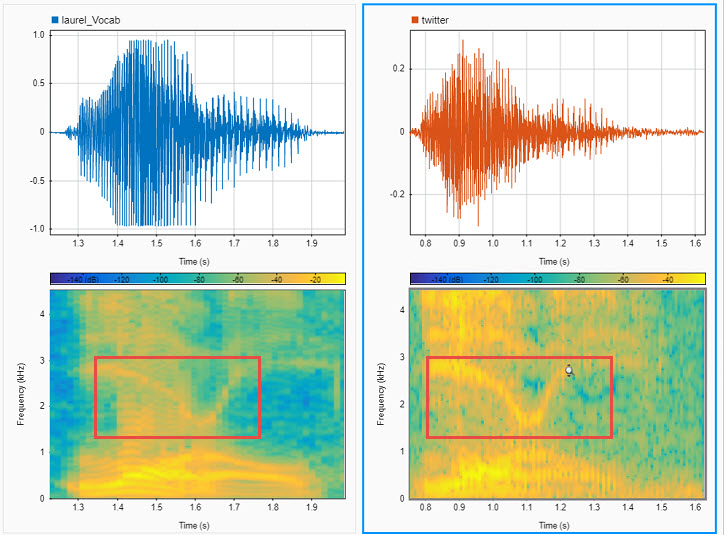MATLAB helps revive The Beatles only live album
Rolling Stone crowned the Beatles the greatest artists of all time. But this amazing group had only one (official) live album to their credit. The Live at the Hollywood Bowl album and featured songs from their performances at the Hollywood Bowl in 1964 and 1965 but unfortunately the sound quality was far from great.
In fact, the recordings were not released for over a decade because they required extensive editing. According to NPR, “Even the label, Capitol Records, concluded the recordings didn’t sound good enough to release. They eventually did, but not until 1977. Even then the album they put out, The Beatles Live At The Hollywood Bowl, sounded just okay.”

Officer Robert Yocum informs Beatle fans Chelie Mylott and Melody Yapscott, right, that they’ll have to move from their spot in front of the Hollywood Bowl. The women had no tickets but hoped to get them from scalpers or sneak in. Image credit: This photo was published in the Aug. 24, 1964 Los Angeles Times. John Malmin/LA Times via Getty Images.
The issue with the sound quality was largely due to the screaming fans. Combined with the fact that the state-of-the-art music recording technology in 1964 was a 3-track analog tape, the fan hysterics drowned out much of the music. The producers did what they could with the soundtrack and although the album peaked at No. 2, it eventually fell out of production.
That all changed this past year when the album was remastered. Giles Martin, the son of The Beatles late producer Sir George Martin, remixed the album at the Abbey Road Studios. This time, modern technology greatly improved the sound quality of the historic recordings.
“It’s hard to think, now, about the technology they had then and how unprepared the world was for the onslaught of rock and roll,” Martin told NPR. “Really, The Beatles were the first stadium band.”
Abbey Road Studios re-engineers the album
Acoustic guitar and vocals share many of the same frequencies. And unfortunately, so do screaming fans! The re-engineering and re-release of the album wasn’t a simple case of filtering by frequency.
“There’s a guy who works in IT here who’s developing de-mix technology, you know, being able to take one track and separate it into its constituent parts,” stated Martin. “I’d been playing around with him with this for a while and I said, ‘Why don’t we try it on screams from the Hollywood Bowl.’ And we tried it and what we ended up with is it split the one track into two tracks and you get the screams on one half and then you have this weird, almost like the band playing but it sounds a little strange. But this meant we could go into, for instance, the drum track and bring out the best of the drums, as opposed to what my father had.”
That “guy from IT” is James Clarke, a systems analyst at Abbey Road Studios. Clarke knew that an off-the-shelf audio processing tool wouldn’t deliver the needed editing capabilities. He developed a “demixing” process to separate each instrumental and vocal track from the crowd noise. According to Wired, “Clarke’s audio-modeling process used spectrograms to bring the spirit of these live performances back to life.”
“It’s a lot of MATLAB, more like a research tool. There’s no graphical front end where you can just load a piece of audio up, paint a track, and extract the audio. I write manual scripts, which I then put into the engine to process,” Clarke says.
MATLAB was used for the audio restoration phase of the project. Clarke recreated digital models, or spectrograms, for each instrument, the vocals, and the screaming crowd in the Hollywood Bowl recordings.
Separating lower frequencies such as the bass guitar and kick drum was straightforward since the screaming fans didn’t crossover to the low frequencies. But many of the instruments, as well as the vocals, were in the same frequency range as the crowd noise, making separating the music from the fan noise more difficult. For this, they created models based on studio recordings.
“I went back to the studio versions to build the models,” stated Clarke. “They’re not as accurate, as there are usually temporal and tuning changes between playing in the studio and playing live, but the Beatles were pretty spot-on between studio and live versions.”
With these spectrogram models, the program created a clean track for each vocal and instrument and a separate track for fan noise. Once the audio restoration phase was completed, the tracks were sent to the mixing engineer. The mixing engineer tweaked each track to create the 2016 reconstruction.
The Beatles album climbs the Billboard charts, again!
When it was re-released in September 2016, it earned The Beatles their 32nd top-ten album on the Billboard charts. This is amazing when you consider their first top-ten album, Meet the Beatles, made the same list 52 years earlier in 1964.
The fan noise was also used as part of the final recreation since the goal was to hear the Beatles playing for the crowd. The energy of the fans was an important part of the music! But the final version did drop the fan noise by nearly 3 decibels.
Now you can also hear for yourself: For comparison, this BBC article shares a snippet of the music, both before and after the remastering of the music. The album is also available on iTunes.









Comments
To leave a comment, please click here to sign in to your MathWorks Account or create a new one.